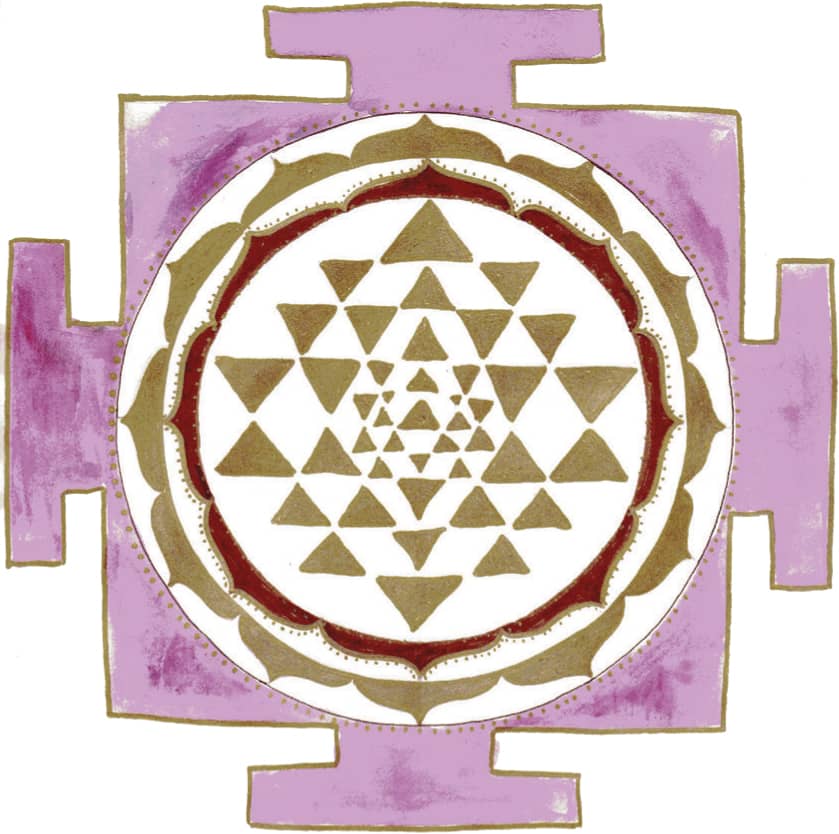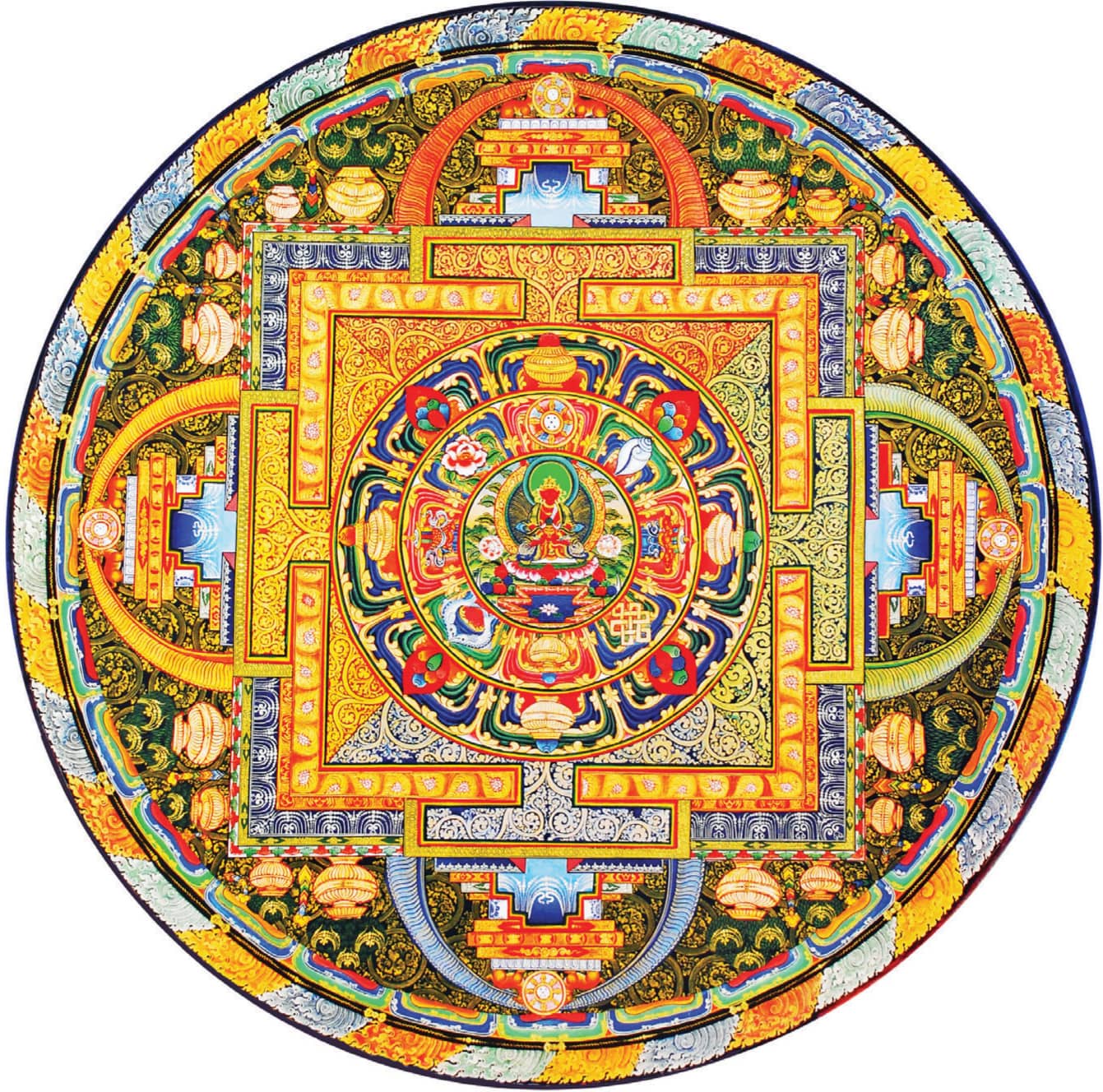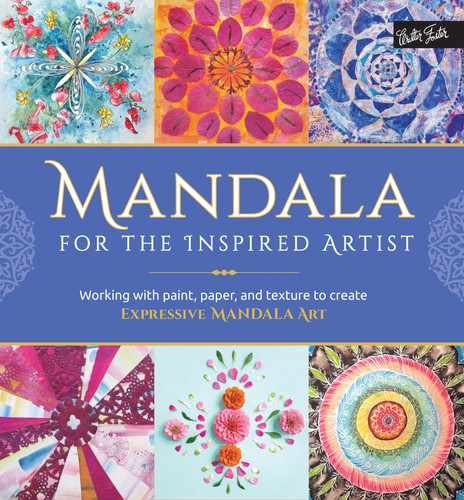MANDALA BASICS
LOUISE GALE
 Mandala Basics
Mandala Basics
WHAT IS A MANDALA?

HAND-DRAWN MANDALA USING THE 8-POINT STRUCTURE AND DEVELOPING INTO 12 MOTIFS AROUND THE EDGE
Mandala comes from the Sanskrit language, loosely meaning “circle.” Mandalas represent more than just a shape, however; they can be seen as a cosmic diagram that signifies the wholeness of the universe.
Most mandalas are circular, with a central point from which various motifs and patterns radiate outward. Mandalas usually contain 8 or 12 sections, which are symmetrical in design.
The purpose and design of any mandala is defined by its creator. It may be just a simple circle, or perhaps a spiral; it might be very detailed and complex, filled with layers of motifs; or it might be an intricate creation of colored sand.
I like to think of a mandala as a sacred space—a circle that tells a story about who we are or represents the world around us. Mandalas are a personal and unique experience that can be both inspirational and therapeutic. In creating them, we open ourselves to all the possibilities that exist inside and outside of ourselves.
WHERE DO MANDALAS COME FROM?

The circle is the most natural form known to mankind, and mandalas reveal themselves to us in all aspects of life—the Earth, the moon, and the sun, as well as through circles of friends, family, and communities. Mandalas are found in the macrocosm and microcosm of nature, from the rotational patterns of planets to the intricate, sacred, geometric pattern of a flower.

MANDALA PATTERNS ON A CHURCH IN JEREZ, SPAIN
Mandalas are specifically associated with traditional Hindu, Tibetan, and Buddhist artwork, but they are also found in other world traditions—the rose windows of Gothic cathedrals, Native American dream catchers and labyrinths, Aboriginal art, and Aztec sunstones, among many others.
Many buildings have also been built using mandalic patterns, often for spiritual purposes, but also as a geometric way to ensure balance and harmony in the architecture or design.
HOW ARE MANDALAS STRUCTURED?
Mandalas have one identifiable center point, from which an assortment of symbols, shapes, and patterns radiate—these vary from culture to culture.
The basic form of a traditional mandala is a square with four “gates” containing a circle. Each gate is in the general shape of a T. Traditional mandalas may also contain a “yantra,” which is a geometric diagram or object. The Sri Yantra is a geometric symbol that is recognizable and thought to be the mother of all yantras. It is also a visible representation of the vibrational sound of “OM.”

SRI YANTRA MANDALA
Some traditions portray images of gods and goddesses, some use color and shape, and others use natural objects. Although each culture may use different symbols, all mandalas describe the same cosmos, which symbolizes unity and harmony for all.
Mandalas can be created with a 4-point, 8-point or 12-point structure using spirals, concentric circles, and other recognizable formations. You can draw them freehand or use a ruler, protractor, and compass to measure sections and create concentric circles. Each mandala design can be structured in a different way, and many consist of various mathematical combinations, themes, or patterns. (See pages 12–18 for more details on drawing your own mandalas.)
HOW DO I CREATE A MANDALA?

PRESSED FLOWER MANDALA
You can use a variety of materials to create mandalas, such as a black pen, paint, collage, pressed flowers, and more! Mandalas can be doodled in your sketchbook, painted on paper, or created as detailed, mixed media masterpieces. You can even create them digitally on the computer or paint on stones and other circular objects, such as old CDs or vinyl records.
Creating temporary mandalas is also a wonderful way to create with and connect to nature. You can use found objects from nature, such as petals and leaves, colored sand, or shells.
HOW ARE MANDALAS USED?
Mandalas have traditionally been used by Buddhists, Hindus, Tibetans, and Native Americans in prayer, meditation, and healing. For example, Tibetan monks use mandalas as a form of meditation—the observer focuses and meditates on the special symbolic meaning within the mandala, considering the entire world through it.
Tibetan monks also create intricate colored sand mandalas, in which the focus is on the act of carefully creating the mandala; once completed, a ceremony is performed in which the sand is poured away.
In the early twentieth century, Swiss psychiatrist and psychotherapist Carl Jung noticed how mandala making was used by many cultures to represent wholeness and healing through ritual. In his book Man and His Symbols (1968), Jung saw this process as a way to facilitate healing through creating art, which would “restore a previously existing order.” He saw mandala as a way for individuals to experience or find wholeness. After many years of drawing his own, Jung eventually realized that, like the designs he was drawing, his own life had been a series of meandering paths that returned to each other and always led back to the center.
As a result of this discovery, the creation of mandalas is used frequently today in art therapy, meditation, and many other methods of journeying into the self or mind.
WHAT ARE THE BENEFITS OF MAKING MANDALAS?
The process of making mandalas centers the mind and produces a sense of peace and calmness. Anyone can use mandalas as a tool for meditation, relaxation, and introspection. The meditative process can feel hypnotic, allowing the creative right side of the brain to take over, while the analytical left side rests. The process can take as little as two minutes to doodle in a sketchbook or up to several hours working on a mixed media painting full of layers, colors, and depth.
I like to draw mandalas as a meditation practice, which helps me get back into my creative flow. I lose myself when I am creating a mandala and find the beauty and completeness of the process one of the most opening and satisfying creative practices.
Anyone can use mandala creation as a tool on their own spiritual journey—looking deeply into the circle of a mandala encourages us to look deeply into ourselves. While there doesn’t necessarily need to be meaning behind your mandalas, you may find symbols that are meaningful to you or that simply convey the beauty in the world.

TIBETAN MANDALA
Coloring mandalas is also a great way to calm the mind. This art form is being used more and more frequently to promote creative play, enabling the right side of the brain to run free. This means that even those who may not want to create a mandala from scratch can still benefit from the healing and reflective process of coloring these sacred circles.
Mandala making is a mindful process, and within this book you will discover tools, techniques, and opportunities to not only create beautiful mandala works of art, but facilitate reflection and relaxation as part of the creative process.

